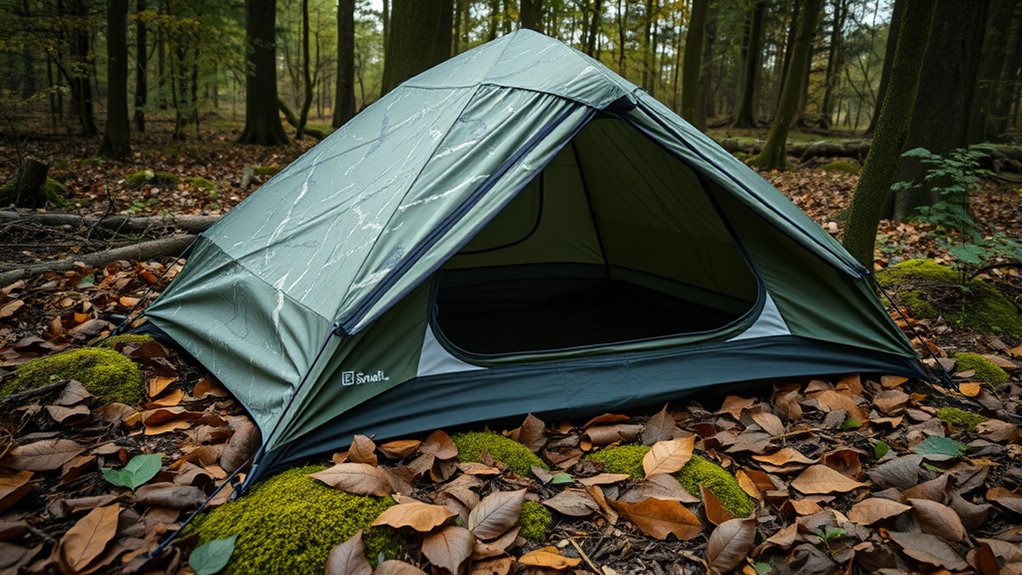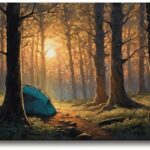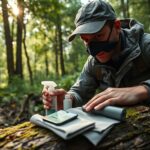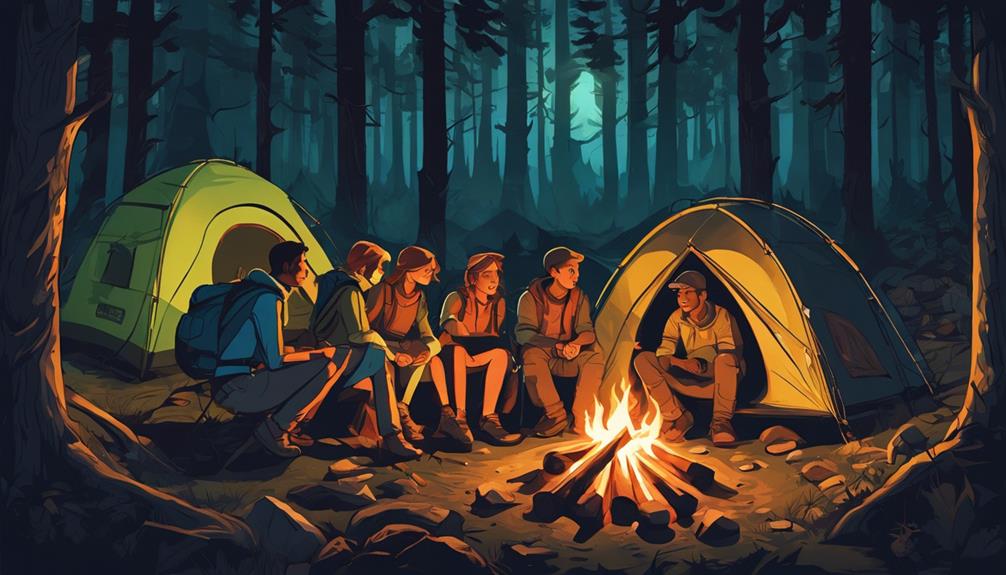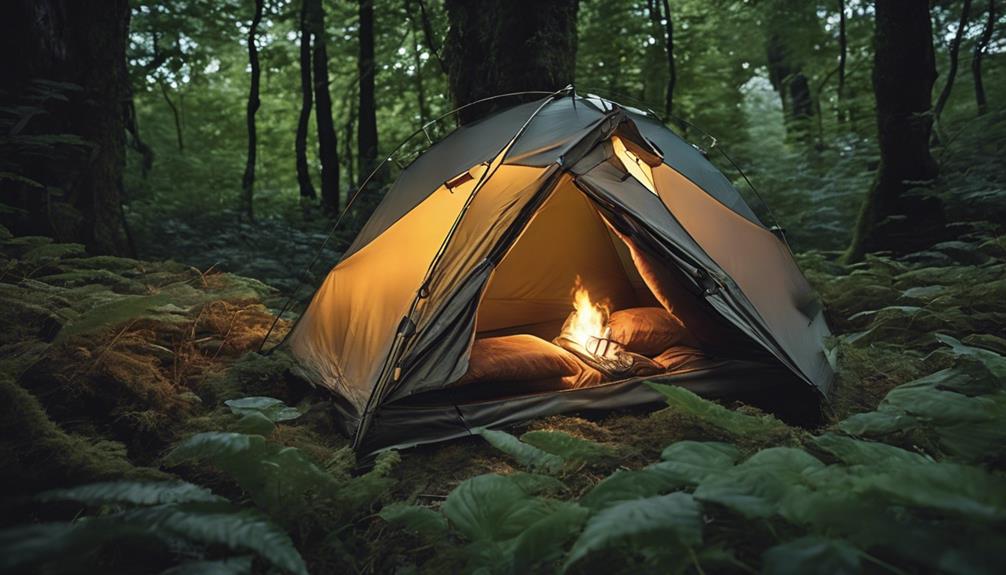To create an invisible camp, you must master natural camouflage principles like blending into your environment seamlessly, choosing locations with natural cover, and using dirt, leaves, and branches to hide your gear. Move quietly and control your scent, avoiding artificial colors that stand out. By working with terrain features and adjusting for weather, you’ll stay hidden from view and detection. If you keep exploring, you’ll uncover even more techniques to perfect your stealth and blend into nature effortlessly.
Key Takeaways
- Select terrain features like dense foliage, rocks, and natural barriers to blend your campsite seamlessly into the environment.
- Use natural materials such as leaves, twigs, and moss to camouflage gear and cover, avoiding artificial colors.
- Position the campsite to face away from common lines of sight, utilizing overhangs or natural concealment points.
- Move slowly and quietly to minimize noise and scent, ensuring stealth during setup and activities.
- Adapt your concealment techniques based on environmental conditions like light, weather, and seasonal changes.
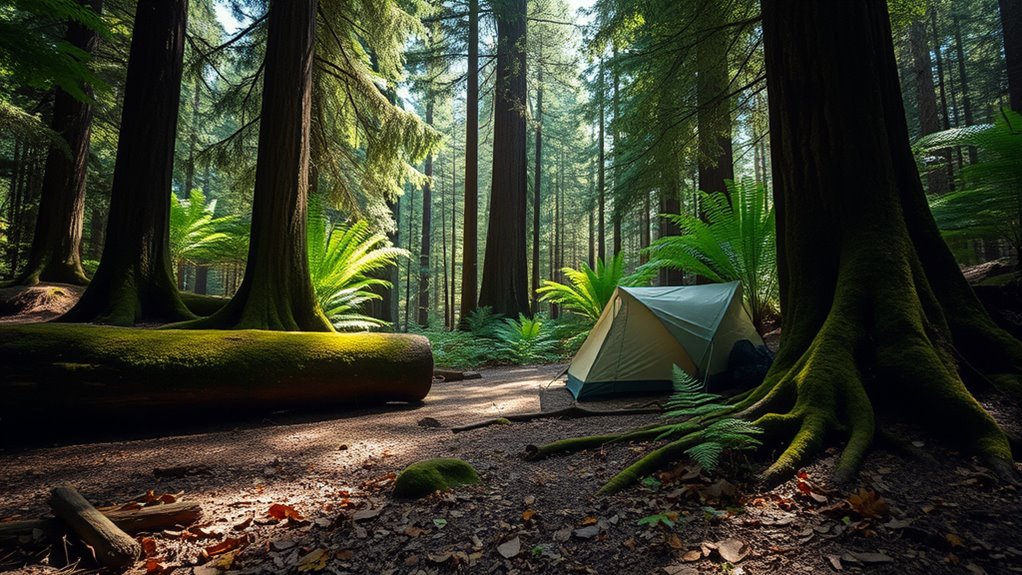
Have you ever wondered how some groups operate quietly in the shadows, unseen by most? The secret lies in mastering natural concealment, a fundamental principle of stealth camping. When you set up an invisible camp, it’s not about hiding behind thick tarps or artificial barriers; it’s about blending seamlessly into the environment. The key is to understand and apply blending techniques that make your presence virtually invisible. These techniques involve more than just hiding; they require you to think like the landscape itself. You need to observe and identify features of the terrain—bushes, rocks, fallen leaves—that you can incorporate into your campsite to break up your silhouette. By doing so, you reduce the chances of being spotted from a distance or from the air.
Natural concealment begins with choosing the right location. Look for areas where the terrain naturally shields you—dense thickets, rocky outcroppings, or beneath overhanging branches. These features act as natural barriers, helping you avoid detection without adding extra cover that might stand out or seem out of place. Once you’ve found a suitable spot, focus on blending techniques. Use the surrounding materials—twigs, leaves, moss—to camouflage your gear and shelter. For instance, scatter leaves and branches over your tent or sleeping area to mimic the natural ground cover. This minimizes the contrast between your campsite and the environment, making it harder for anyone to distinguish your setup from the background.
Choose natural features like thickets and rocks to hide and blend your campsite seamlessly into the environment.
Stay mindful of your movement and scent as well. Moving carefully and slowly, avoiding unnatural sounds, can help you stay invisible longer. Keep your presence low by avoiding bright-colored gear; instead, opt for earth tones that match your surroundings. When setting up, position yourself so that your back faces natural cover, and avoid open spaces where you’re exposed. Remember, the goal isn’t just to hide but to appear as part of the landscape. That’s where mastery of blending techniques truly shines. Over time, you’ll learn to anticipate how the environment changes with light, weather, and seasons, adjusting your concealment strategies accordingly. Incorporating knowledge about visual camouflage can further enhance your stealth efforts.
Ultimately, creating an invisible camp hinges on respecting the environment and understanding how to work with it. By harnessing natural concealment and honing your blending techniques, you can camp undetected and enjoy a seamless connection with nature’s quiet, hidden corners. It’s a skill that transforms your experience from one of mere survival to true stealth mastery, making your presence virtually unnoticeable to the world around you.
Frequently Asked Questions
How Do Weather Conditions Affect Natural Camouflage Effectiveness?
Weather impact profoundly influences natural camouflage effectiveness. Rain and humidity can weaken camouflage durability, causing materials to fade or wash away, reducing your concealment. Wind and snow alter the environment’s appearance, making it harder to blend in. Additionally, extreme temperatures can degrade natural cover faster. To stay concealed, you must adapt your camouflage to weather conditions, maintaining its durability and seamlessly integrating into your surroundings despite changing weather.
What Are Common Mistakes to Avoid When Blending Into the Environment?
When blending into the environment, avoid common mistakes like wearing mismatched camouflage clothing that stands out or neglecting scent masking, which can give you away. Don’t ignore your movement; stay still and deliberate. Also, avoid flashy accessories or bright colors. Always test your camouflage in the environment beforehand, and stay aware of wind direction to minimize scent detection, ensuring your concealment remains effective and natural.
Can Natural Camouflage Techniques Be Used in Urban Settings?
Think of city streets as your jungle, where natural camouflage can still work. You can adapt techniques like matching your clothing to urban surroundings, using shadows and textures for city stealth, and blending into the environment. Urban adaptation requires sharp eyes and subtle movements, just like in nature. With careful observation and smart choices, you can master city stealth, making yourself less noticeable amid the concrete and chaos.
How Do Different Landscapes Require Specific Camouflage Strategies?
Different landscapes demand tailored camouflage strategies. You’ll want to match flora patterns in forested areas to blend with leaves and branches, while open terrains benefit from colors and textures that mimic soil or grass. In rocky regions, terrain textures like jagged edges and stone hues help you stay concealed. By observing and mimicking these natural features, you stay hidden, making your camouflage effective regardless of the environment.
What Safety Precautions Should Be Taken While Practicing Stealth Camping?
When stealth camping, you need to prioritize safety by wearing camouflage clothing that blends with the environment and using scent masking techniques to avoid detection. Always inform someone about your location, carry a map and compass, and stay aware of local regulations. Keep noise to a minimum, and be prepared for emergencies. These precautions help guarantee your safety while respecting the natural surroundings and maintaining stealth.
Conclusion
Now that you’ve uncovered these natural camouflage secrets, you’re like a shadow slipping through the woods, unseen yet ever-present. By blending with your surroundings, you become a ghost in the night, silent and safe. Remember, stealth isn’t just about hiding; it’s about becoming part of the landscape itself. With these principles, you’ll move like a whisper, invisible as the wind—exploring your wilderness sanctuary with confidence and quiet mastery.

